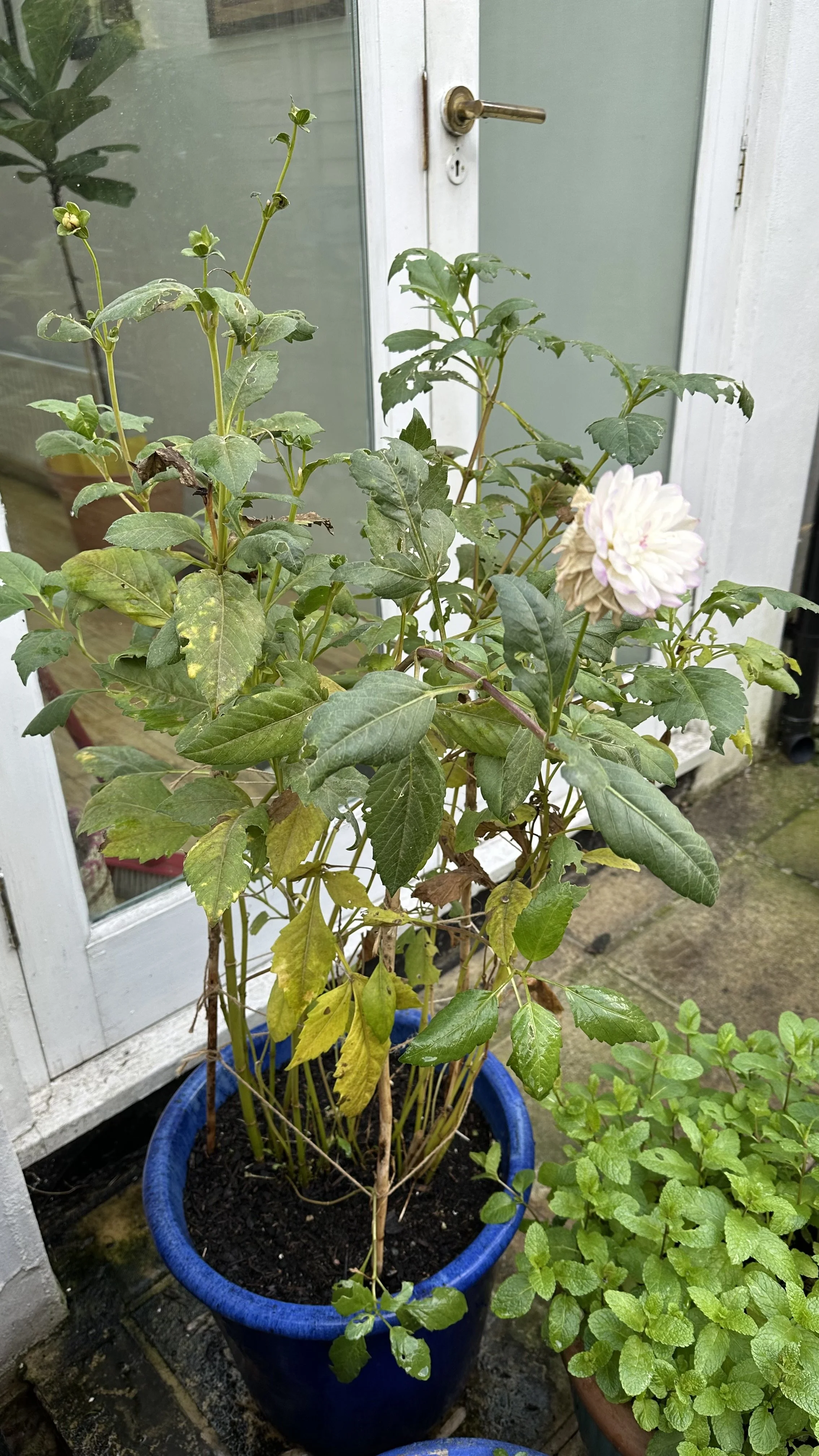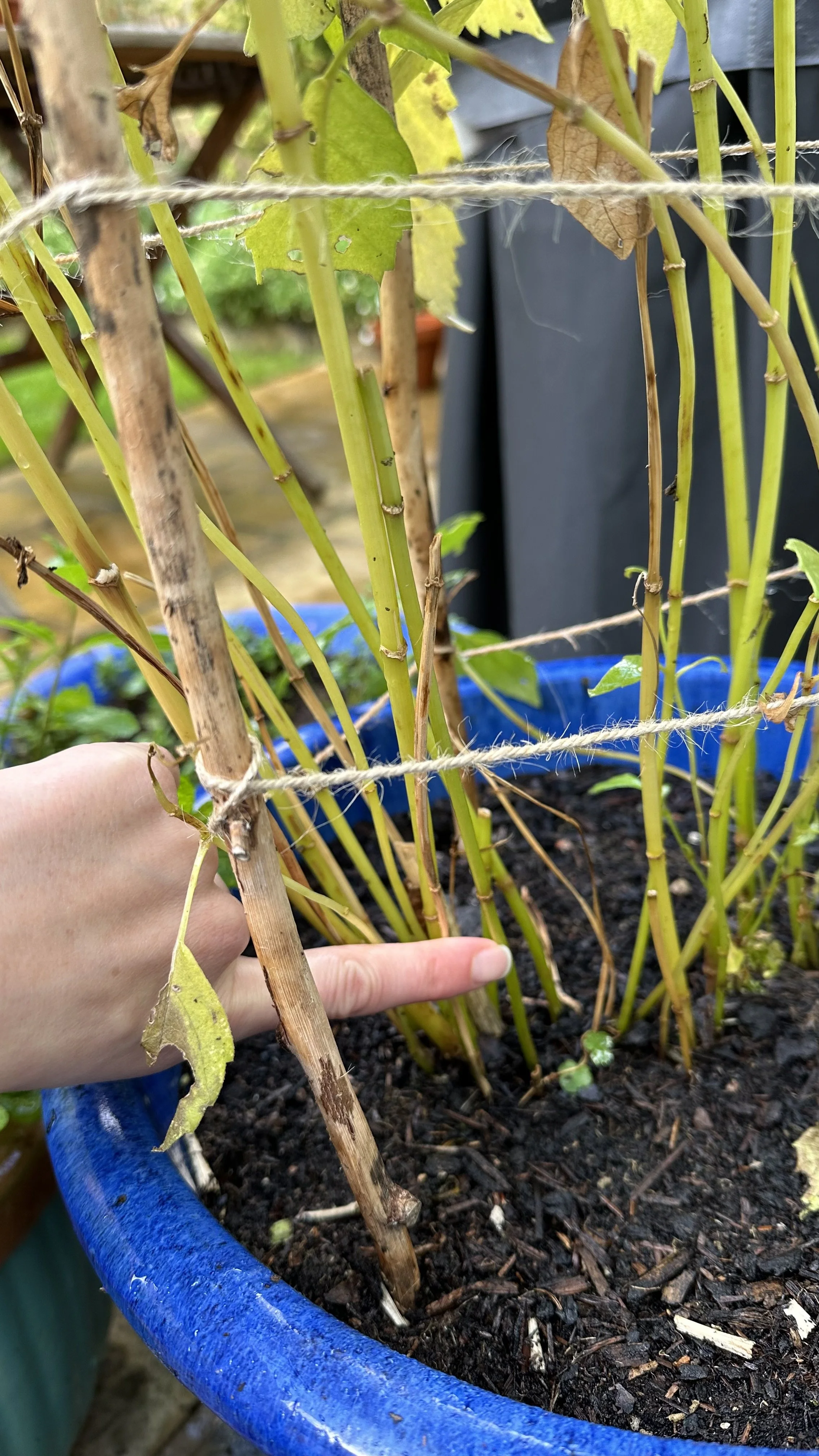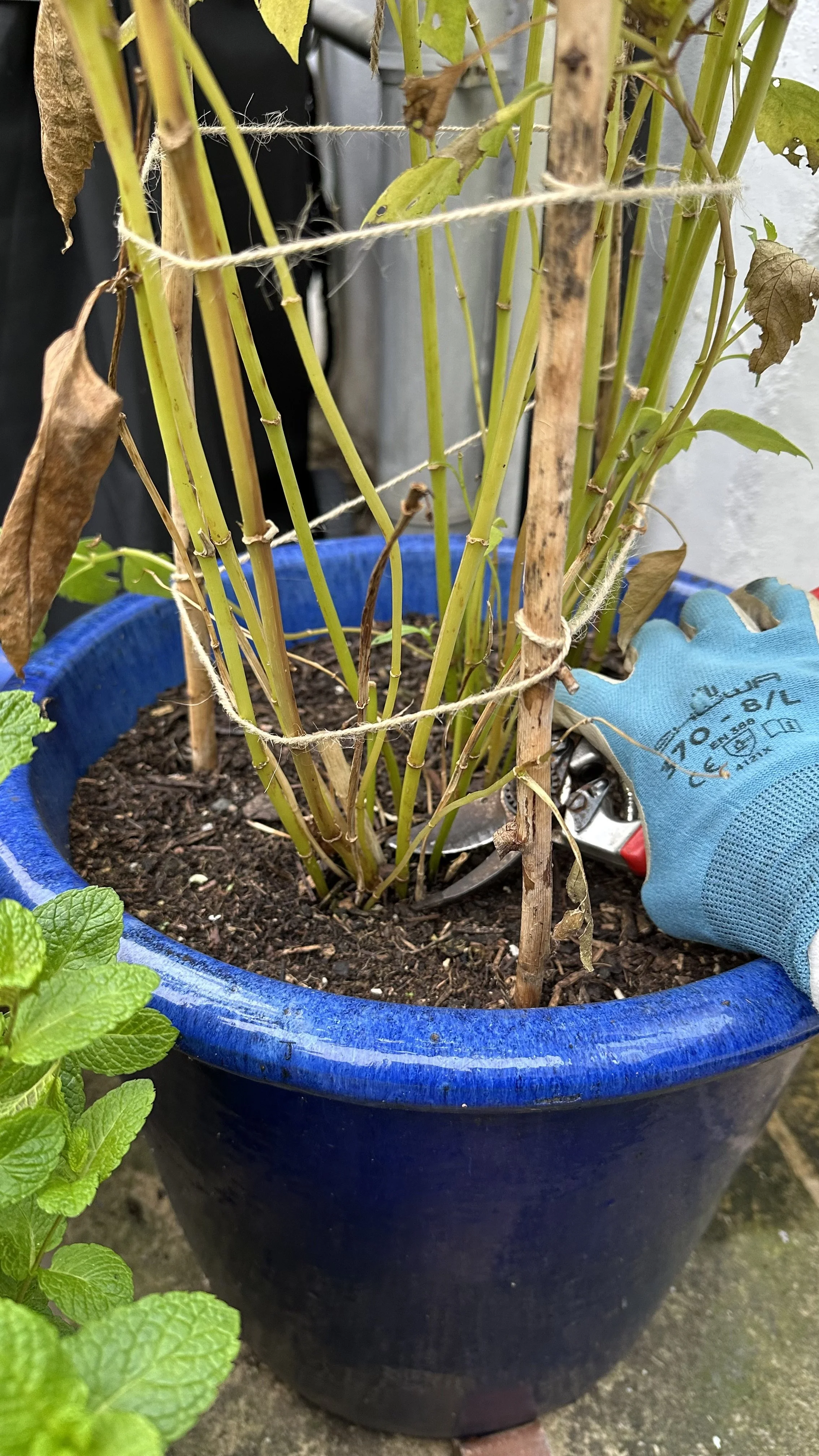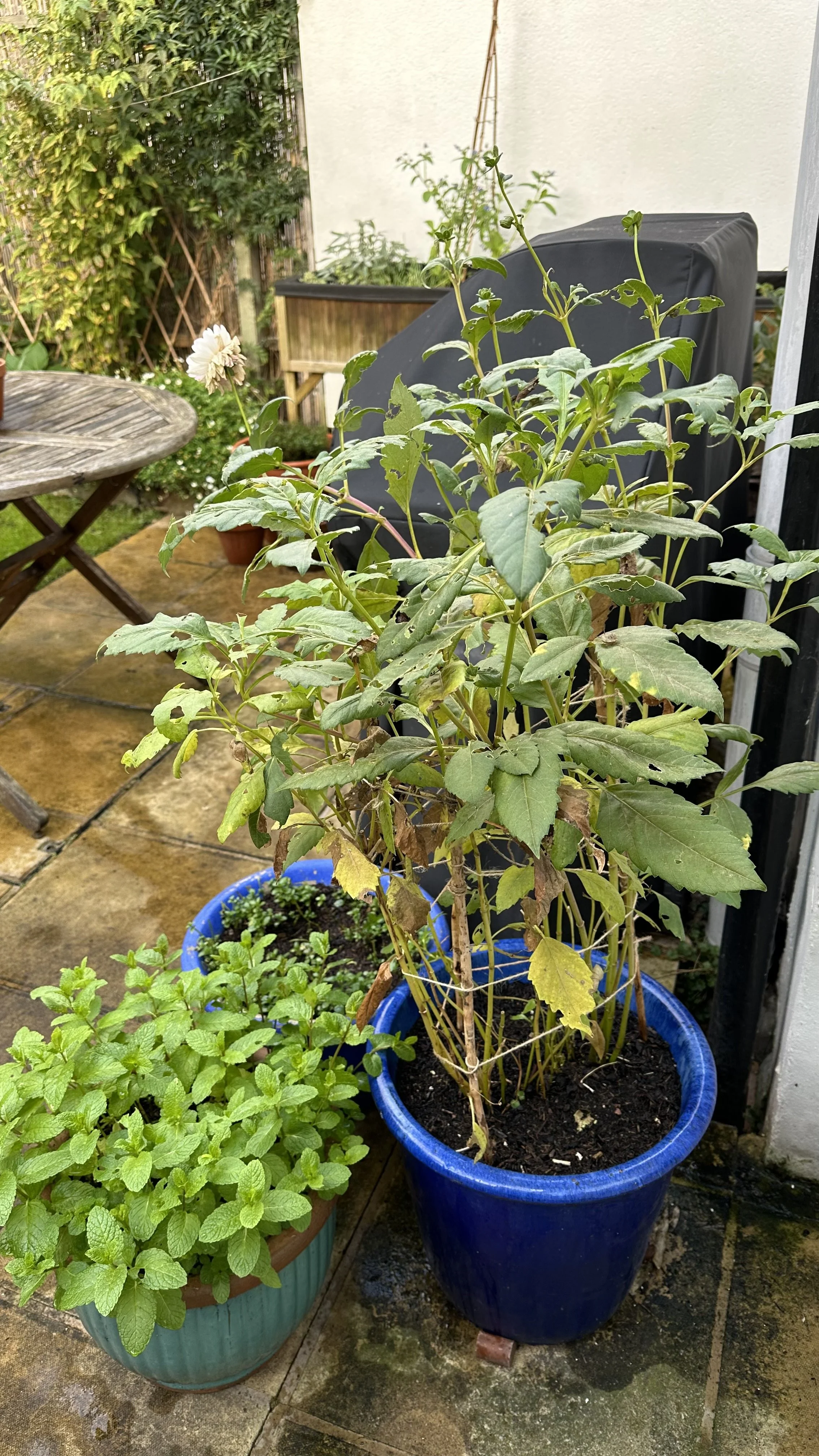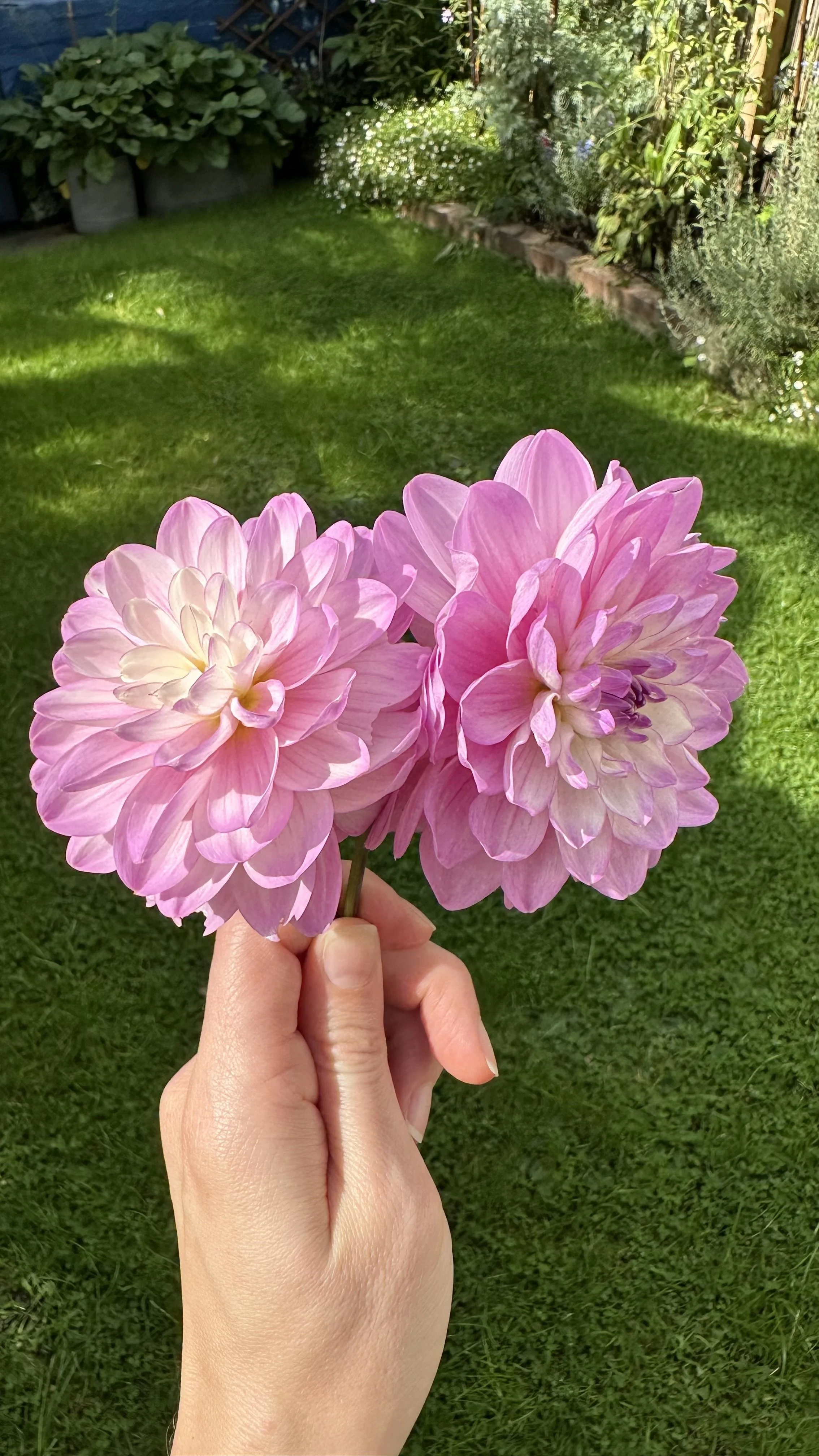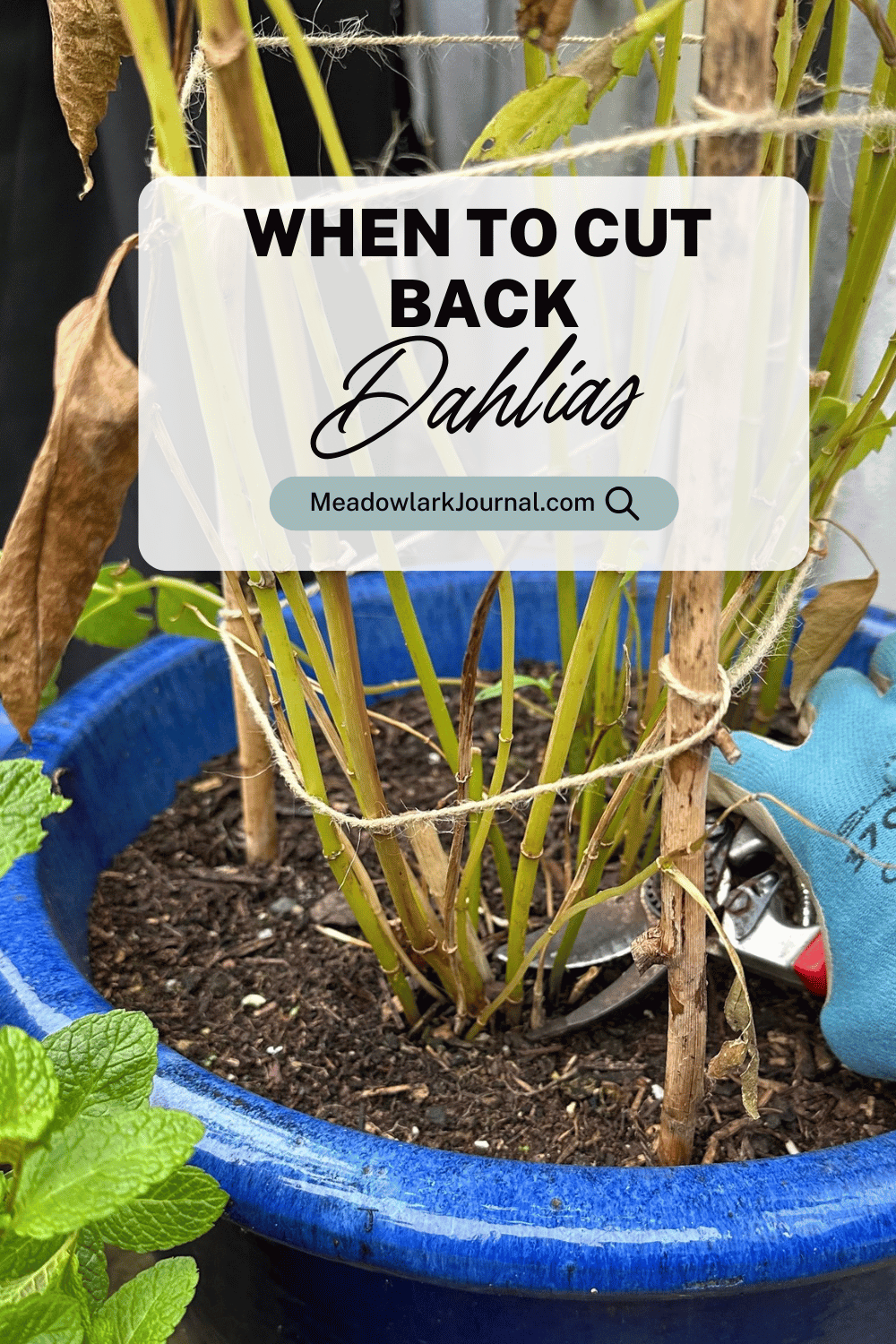When to Cut Dahlias Back: Easy Guide
This website is reader-supported - thank you! This post may contain affiliate links. As an Amazon Associate, I earn from qualifying purchases at no extra cost to you.
If you’ve been growing dahlias this season, you might be wondering when to cut dahlias back and how to prepare them for winter.
Timing is everything with these gorgeous blooms, and knowing when to prune can make all the difference in ensuring healthy growth next year.
Whether you’re dealing with your first frost or thinking about storing your tubers, cutting back dahlias properly is a simple task that goes a long way.
In this guide, I’ll walk you through when and how to trim your dahlia plants, plus tips for storing tubers and getting them ready for another season of beautiful flowers.
To learn more about growing dahlias, check out my guides:
My potted dahlia at the end of the season.
Understanding the Right Time: Before the First Frost
Timing is everything when it comes to cutting back dahlias.
You want to wait until just after the first frost, which acts as a signal that the growing season has ended.
Frost causes the dahlia leaves to turn black and wilt, indicating that the plant has gone dormant.
At this stage, it’s safe to start pruning because the plant has already shifted its energy from the leaves and stems down to the tubers underground.
What Is the First Frost, and Why Does It Matter?
The first frost is typically the first time in late fall when temperatures drop low enough (below 32°F or 0°C) for ice crystals to form on surfaces, including your plants.
For dahlias, this temperature drop stops active growth and sends a message to the plant to conserve energy in its tubers for winter.
Cutting back your dahlias before the frost might seem like a good idea, but it’s better to wait.
If you cut too early, the plant won’t have enough time to transfer its nutrients to the tubers, potentially weakening them.
Waiting for the first frost ensures that your dahlias have finished this natural process, which is crucial for healthy growth next year.
How to Spot the First Frost in Your Area
The timing of the first frost varies based on your region.
In colder climates, it might occur as early as September, while in milder areas, it could be late October or even early November.
Keep an eye on your local weather forecasts and watch for signs in your garden:
Blackened Leaves: This is the most obvious indicator that frost has arrived and the growing season is over for dahlias.
Drooping Stems: After a frost, dahlia stems tend to sag as the cold damage sets in.
Colder Night Temperatures: When nighttime temperatures consistently hover around freezing, the first frost is imminent.
If you’re unsure about frost timing in your area, you can look up average frost dates for your region using the Farmer’s Almanac site.
This will help you plan your pruning and tuber storage schedule with more confidence.
Tip:
If you’re unsure when the first frost usually hits, check your local weather trends or consult the Farmer’s Almanac site.
It can make a big difference in the health of your dahlia tubers.
The learn more about pruning, check out my guides:
Pruning Salvias: How to Prune for Abundant Flowers
Lavender Pruning: A Simple Guide
Pruning Winter Jasmine: Simple Guide
Where to cut back dahlia on the stem.
How to Cut Back Dahlias for the Winter: A Step-by-Step Guide
Once the first frost hits and your dahlia plants show signs of frost damage (like blackened, droopy leaves), it’s time to start cutting them back.
Proper pruning helps tidy up the garden and sets the stage for healthier growth next year.
Here’s a step-by-step guide to ensure you do it correctly:
Step 1: Gather Your Tools
Before you start, make sure you have the right tools on hand.
You’ll need:
Sharp pruners or garden shears:
These make clean cuts and reduce the risk of damaging the stems.
Here are the ones I recommend:
Gardening gloves:
Dahlia stems can be slightly prickly, so gloves help protect your hands.
Here are the ones I recommend:
A bucket or garden bag:
To collect the cuttings and dispose of them easily.
Step 2: Cut the Stems Back
Trim the stems down to about 4-6 inches above the soil line.
This length is ideal because it leaves a small portion of the stem visible, making it easier to find the tubers if you plan to dig them up later.
When cutting, make sure your pruners are clean and sharp to avoid crushing the stems, which can invite disease.
Pro Tip:
Make angled cuts to allow water to run off, reducing the risk of rot.
Step 3: Remove Dead Foliage and Flower Buds
Clear away any dead leaves, old flower buds, and remaining debris around the base of the plant.
This helps prevent fungal issues and keeps the area around the tubers clean.
Be thorough, as decaying plant matter can harbor pests or diseases over winter.
Why It Matters:
Removing the old foliage reduces the chance of overwintering pests and helps prevent rot, which could damage your tubers.
Step 4: Inspect the Soil and Decide on Tuber Storage
Next, take a close look at the soil and assess your winter conditions.
This is an important step because your decision to dig up or leave the tubers in the ground depends on how cold your winters get.
In Colder Climates:
If your area experiences hard freezes where the soil freezes solid, you’ll need to dig up the dahlia tubers.
Frozen soil can kill the tubers, so it’s best to store them indoors.
In Milder Climates:
If your winters are milder and the ground doesn’t freeze deeply, you can leave the tubers in the soil.
However, be sure to cover the area with a thick layer of mulch (like straw, leaves, or compost) to provide insulation.
Step 5: Clean Up and Dispose of Cuttings
After you’ve finished pruning, collect all the cuttings and dead foliage.
Don’t compost these, as they may carry pests or disease spores.
It’s safer to dispose of them in your yard waste bin.
For more garden inspiration, check out my guides:
Cutting back dahlias.
Should You Dig Up or Leave Dahlias in the Ground?
One of the biggest questions for dahlia growers at the end of the season is whether to dig up the tubers or leave them in the ground over winter.
The right choice largely depends on your climate and how harsh your winters are.
Let’s look at both options and what you need to consider.
Option 1: Digging Up Your Dahlia Tubers
If you live in a region where winters are harsh and the soil freezes solid, digging up your dahlia tubers is the safest option.
Frozen ground can damage or kill the tubers, and you might lose your plants for good.
Here’s what you need to do:
Step-by-Step Guide to Digging Up Tubers:
Wait Until After the First Frost:
The first frost signals the plant to go dormant.
Once the foliage has blackened, it’s safe to dig up the tubers without impacting their health.
Use a Garden Fork or Spade:
Carefully loosen the soil around the base of the plant using a spade.
Be gentle to avoid slicing into the tubers.
Lift the Clump of Tubers:
Grasp the main stem and gently lift the entire clump out of the ground.
Shake off any excess soil.
Rinse and Dry the Tubers:
Rinse off the remaining dirt with a gentle spray of water.
Allow the tubers to dry for a day or two before storing them.
This helps prevent mold during storage.
Storage Tips:
Store the tubers in a cool, dry place like a basement, garage, or cellar.
Place them in a container filled with sawdust or sand to keep them dry and insulated.
Check on them periodically over winter for signs of mold or rot.
Pros of Digging Up Tubers:
Protection from Freezing: You avoid the risk of frost damage, which can be fatal to dahlia tubers.
Easier to Divide Tubers: When stored indoors, you can inspect and divide your tubers in early spring before planting, helping your dahlia plants multiply.
Option 2: Leaving Dahlia Tubers in the Ground
In milder climates where the ground doesn’t freeze deeply, you have the option of leaving the tubers in the soil over winter.
This approach can save time and effort, but you’ll need to take some precautions to ensure the tubers survive until spring.
How to Protect Tubers Left in the Ground:
Cut Back the Stems:
Trim the dahlia stems to 4-6 inches above the soil after the first frost.
Mulch Generously:
Cover the area with a thick layer of mulch (about 4-6 inches deep).
Use materials like straw, leaves, or compost.
Mulch acts as a blanket, insulating the tubers from temperature fluctuations.
Here is the mulch I recommend:
Keep the Soil Well-Drained:
Make sure the soil drains well and doesn’t become waterlogged, as soggy conditions can lead to rot.
Pros of Leaving Tubers in the Ground:
Less Labor-Intensive: You avoid the extra step of digging up and storing the tubers.
Earlier Growth in Spring: Tubers left in the ground often sprout earlier in the spring, giving you a head start on the growing season.
Cons of Leaving Tubers in the Ground:
Risk of Rot and Disease: If your soil tends to stay wet over winter, tubers can easily rot.
Unpredictable Weather: An unusually cold winter could freeze the ground deeper than expected, damaging the tubers.
How to Decide What’s Best for Your Garden
To make the best decision, consider the following:
Your Climate Zone:
If you live in USDA hardiness zones 8-10, where winters are mild, you can likely leave your dahlias in the ground.
In zones 7 and below, it’s generally safer to dig them up.
Soil Type:
Well-draining soil is crucial if you plan to leave tubers in the ground.
Heavy clay soil tends to hold water, increasing the risk of rot.
Your Gardening Goals:
If you want to divide and propagate your dahlias, digging them up each year is more practical.
If you prefer a lower-maintenance approach, leaving them in the ground might be a better fit.
For more tips, check out my guides:
My potted dahlia at the end of the season.
What Happens If You Don’t Cut Back Dahlias?
It might be tempting to skip pruning and leave your dahlia plants as they are when the growing season ends, but doing so can have several negative effects on the health and vigor of your dahlias.
Let’s explore what happens if you don’t cut back your dahlias before winter.
1. Weaker Growth Next Year
Leaving the old stems and foliage on the plant can lead to weaker, less vigorous growth when spring arrives.
Dahlia plants naturally transfer nutrients from the leaves and stems to the tubers as they go dormant.
By not cutting back the dead or dying parts, you interfere with this process, and the tubers may not store as much energy as they need for a strong start in the new season.
Why This Matters: Healthy, well-pruned dahlias have a better chance of producing strong shoots and vibrant flowers when they re-emerge in spring.
2. Increased Risk of Pests and Disease
Dead dahlia foliage can become a breeding ground for pests and diseases.
When you leave the old stems and leaves on the plant, they can harbor insects like slugs and aphids, which can easily damage the new shoots next year.
Additionally, fungal diseases like powdery mildew and botrytis can overwinter on the decaying plant material and spread to healthy parts of the plant in spring.
Common Issues to Watch Out For:
Powdery Mildew: This fungal disease thrives in damp, cool conditions and can spread powdery mildew from infected, unpruned foliage.
Botrytis Blight: Another fungal problem that can overwinter in dead plant material and cause rot in the new growth.
Solution: By cutting back the stems and removing dead leaves, you minimize the risk of these issues and help protect your garden.
3. Potential for Rotting Tubers
If you leave the dahlia foliage and stems untrimmed, the decaying plant material can trap moisture around the base of the plant.
This excess moisture can seep down into the soil, creating a damp environment that encourages tuber rot.
Rotting tubers won’t survive winter storage or the next growing season, which could mean losing your dahlia plants entirely.
Rot Prevention Tip:
After pruning, clear away all debris and consider mulching the area to help maintain proper moisture levels in the soil.
Check out my guide: The Best Alternatives to Traditional Mulch for Your Garden.
4. Messy, Untidy Appearance
While aesthetics aren’t everything, leaving dead stems and foliage in the garden can make your flower beds look unkempt throughout the winter months.
A tidy cutback not only prepares your dahlias for the next season but also keeps your garden looking well-maintained during the dormant period.
Bonus Benefit: Tidying up at the end of the season also makes it easier to plant winter cover crops or add mulch to protect the soil.
5. Missed Opportunity for Tuber Inspection and Division
Cutting back your dahlias gives you the perfect chance to inspect and dig up the tubers if needed.
This is especially important if you want to divide your dahlia plants to create more blooms next year.
By skipping the cutback, you might miss early signs of issues like mold, rot, or pest damage on the tubers, which could affect their viability.
Why Inspection Matters: Catching problems early allows you to treat or discard affected tubers before they have a chance to spread issues in your garden.
Prepping for Spring: When to Plant Dahlias Again
As spring rolls around, you can start planting dahlias again once the threat of frost has passed.
Dahlias love full sun and well-draining soil, so find a sunny spot in your garden to give them the best start.
Typically, planting in late May or early June works well for most climates.
For more tips, check out my guides:
FAQs
When should I cut my dahlias back for winter?
You should cut back dahlias right after the first frost, when the leaves turn black and the plant goes dormant.
This signals that the growing season has ended and the plant has stored enough energy in its tubers.
Pruning at this stage helps prepare the plant for winter and reduces the risk of rot and pests.
Aim to do this in late fall, depending on your local climate.
How do I know when the first frost will happen?
The first frost typically occurs in late fall, but the exact timing can vary based on your location.
You can look up average frost dates for your region using the Farmer’s Almanac site, or keep an eye on weather forecasts for temperatures dipping below 32°F (0°C).
Garden signs like blackened leaves or drooping stems also indicate that frost has arrived.
It’s important to act quickly after the first frost for optimal pruning.
Can I leave dahlias in the ground over winter?
Yes, you can leave dahlia tubers in the ground if you live in a region with mild winters where the soil doesn’t freeze deeply.
However, you should cover them with a thick layer of mulch to protect against cold snaps.
In colder climates where the ground freezes hard, digging up the tubers is a safer option to prevent damage.
Proper mulching or storage is key to helping them survive the winter.
How do I store dahlia tubers over winter?
To store dahlia tubers, first rinse off any remaining soil and allow them to air dry for a day or two.
Place the dried tubers in a container filled with sawdust, or sand to keep them dry and insulated.
Store them in a cool, dark place like a basement or garage, ideally between 40-50°F (4-10°C).
Check on them occasionally for signs of mold or rot and remove any affected tubers.
Final Thoughts
Pruning dahlias might feel like an extra step in your fall gardening routine, but it’s well worth the effort for healthier plants and more blooms next season.
By taking the time to trim back your dahlias now, you’re setting them up for success and preventing common issues that might have affected your garden last year.
Whether you decide to dig up and store your tubers or leave them in the ground, a little care and proper pruning will help your dahlias thrive when spring arrives.
With these tips, you’ll be ready to enjoy a stunning display of flowers year after year.
For more tips, check out my guides:
Pin this post to save it for later!
